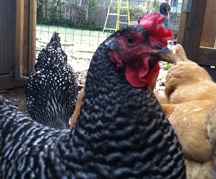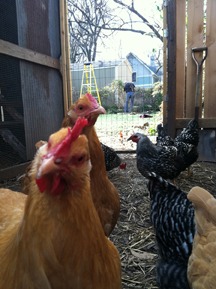
Rocky - the ring leader
A few weeks ago, my husband and I decided our seven hens needed to stretch their legs. They have their own little chicken house with a miniature yard, but we thought they might be getting a little cooped up in there.
So my husband released them out into the larger part of our backyard, freeing them to run, play and search for bugs.
It wasn’t long before one of the more courageous birds flew over the fence and into the neighbor’s yard.
We had heard that clipping their wings might be necessary to keep them from flying through the neighborhood, but we didn’t want to do it. It sounded kind of cruel.
After a little research, we were assured that the chick feels nothing when her wing is clipped. To keep the chick from flying, just a little outer feather on one wing is trimmed. Just enough to create a slight imbalance in the wing-flapping so flight becomes impossible.
The bird can only fly if its wings beat perfectly in sync. The wings must be completely in balance before flight can occur.
All this talk of wings reminds me of BKS Iyengar’s metaphor comparing yoga practice to birds in flight.
Iyengar says, “A bird cannot fly with one wing. In the same way, we need the two wings of abhyasa and vairagya to soar.”
Abhyasa and Vairagya are Sanskrit words that represent big concepts. These two aspects of our being work together in order for us to move forward with our yoga.
Abhyasa means more than just practice. It means persistent effort, constant practice, practice sustained over a period of time. In abhyasa we harness the power of our will. We work hard. We try, fail, and get back up again and try some more. Abhyasa would be akin to what happens when soldiers are in basic training. There is a strong emphasis on action, on the doing, on the moving in the direction of a goal.
Vairagya means more than just renunciation. It implies desirelessness, surrendering of the outcome, being at ease with what is. In twelve-step programs it’s called “the serenity to accept the things I cannot change.”
These concepts only seem to counteract one another. Really, they coordinate in such a way that balance is possible. Just like the coordination of the bird’s wings enables flight.
Nothing happens without the focus, attention and hard work of abhyasa. Especially if you are a beginner! Overcoming the inertia of your pre-yoga days takes a tremendous exertion of your will. Just getting out of bed in the morning to do a yoga practice may require a Herculean effort on your part.
When I work with beginners, we focus on what parts of the body have to work in each pose. In the standing poses, students learn how to work their feet and legs. In downward facing dog, students learn how to work their arms. This is the beginning. You must stoke the fire of your will.
Except for the final relaxation pose (savasana), we don’t work much with vairagya in the beginning. You have to turn on the power and get it going, before you can expect to harness it and let go.

Foreground: Ginger. Background: My husband shoring up our fence.
Working under the guidance of a teacher, you learn how to work hard. You try something, you make a mistake, you try again, you err, you try yet again. You learn by doing. The teacher is there to help minimize the error, so that you can continue the work of practice.
This week, focus on what abhyasa means to you. What does practice feel like to you? How do you know when you are working hard? What are some ways that you have shown self-discipline? What kind of goal is worth that kind of discipline?
In the meantime, know that our seven hens are still flying. Instead of limiting their freedom by clipping their wings, we are adjusting our fence so it’s just a little bit higher. I’ll keep you posted on how it goes.